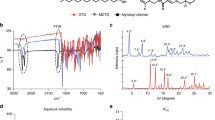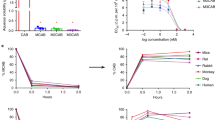Abstract
Purpose
Developing and testing of microbicides for pre-exposure prophylaxis and post-exposure protection from HIV are on the list of major HIV/AIDS research priorities. To improve solubility and bioavailability of highly potent anti-retroviral drugs, we explored the use of a nanoparticle (NP) for formulating a combination of two water-insoluble HIV inhibitors.
Methods
The combination of a non-nucleoside HIV reverse transcriptase inhibitor (NNRTI), Efavirenz (EFV), and an inhibitor of HIV integrase, Elvitegravir (ELV) was stabilized with a graft copolymer of methoxypolyethylene glycol-polylysine with a hydrophobic core (HC) composed of fatty acids (HC-PGC). Formulations were tested in TZM-bl cells infected either with wild-type HIV-1IIIB, or drug-resistant HIV-1 strains. In vivo testing of double-labeled NP formulations was performed in female rats after a topical intravaginal administration using SPECT/CT imaging and fluorescence microscopy.
Results
We observed a formation of stable 23–30 nm NP with very low cytotoxicity when EFV and ELV were combined with HC-PGC at a 1:10 weight ratio. For NP containing ELV and EFV (at 1:1 by weight) we observed a remarkable improvement of EC50 of EFV by 20 times in the case of A17 strain. In vivo imaging and biodistribution showed in vivo presence of NP components at 24 and 48 h after administration, respectively.
Conclusions
insoluble orthogonal inhibitors of HIV-1 life cycle may be formulated into the non-aggregating ultrasmall NP which are highly efficient against NNRTI-resistant HIV-1 variant.





Similar content being viewed by others
Abbreviations
- AF488:
-
Alexa Fluor 488
- DP:
-
Degree of polymerization
- EFV:
-
Efavirenz
- ELV:
-
Elvitegravir
- HC-PGC:
-
Hydrophobic core protected graft copolymer
- INSTI:
-
Strand transfer inhibitor of HIV integrase
- MPEG-gPLL:
-
methoxypoly(ethylene glycol)- graft-N-ε-poly-l-lysine
- M5P10OL:
-
methoxypoly(ethylene glycol)5000- graft-N-ε-poly-l-lysine (DP 55) acylated with oleic acid
- M5P10ST:
-
methoxypoly(ethylene glycol)5000-graft- N-ε-poly-l-lysine (DP55) acylated with stearic acid
- NNRTI:
-
non-nucleoside reverse transcriptase inhibitor
References
Frankel AD, Young JA. HIV-1: fifteen proteins and an RNA. Annu Rev Biochem. 1998;67:1–25.
Katz RA, Skalka AM. The retroviral enzymes. Annu Rev Biochem. 1994;63:133–73.
Witvrouw M, Van Maele B, Vercammen J, Hantson A, Engelborghs Y, De Clercq E, et al. Novel inhibitors of HIV-1 integration. Curr Drug Metab. 2004;5(4):291–304.
Anthony NJ. HIV-1 integrase: a target for new AIDS chemotherapeutics. Curr Top Med Chem. 2004;4(9):979–90.
Schiller DS, Youssef-Bessler M. Etravirine: a second-generation nonnucleoside reverse transcriptase inhibitor (NNRTI) active against NNRTI-resistant strains of HIV. Clin Ther. 2009;31(4):692–704.
Garvey L, Winston A. Rilpivirine: a novel non-nucleoside reverse transcriptase inhibitor. Expert Opin Investig Drugs. 2009;18(7):1035–41.
PubChem Compound Database; CID=64139, https://pubchem.ncbi.nlm.nih.gov/compound/64139 In.: National Center for Biotechnology Information. Accessed 27 Feb 2019.
PubChem Compound Database; CID=5277135, In.: National Center for Biotechnology Informationhttps://pubchem.ncbi.nlm.nih.gov/compound/5277135. Accessed 27 Feb 2019.
Torchilin VP. Micellar nanocarriers: pharmaceutical perspectives. Pharm Res. 2007;24(1):1–16.
Cagel M, Tesan FC, Bernabeu E, Salgueiro MJ, Zubillaga MB, Moretton MA, et al. Polymeric mixed micelles as nanomedicines: achievements and perspectives. Eur J Pharm Biopharm. 2017;113:211–28.
Upponi JR, Jerajani K, Nagesha DK, Kulkarni P, Sridhar S, Ferris C, et al. Polymeric micelles: Theranostic co-delivery system for poorly water-soluble drugs and contrast agents. Biomaterials. 2018;170:26–36.
Mandal S, Prathipati PK, Kang G, Zhou Y, Yuan Z, Fan W, et al. Tenofovir alafenamide and elvitegravir loaded nanoparticles for long-acting prevention of HIV-1 vaginal transmission. AIDS. 2017;31(4):469–76.
Machado A, Cunha-Reis C, Araujo F, Nunes R, Seabra V, Ferreira D, et al. Development and in vivo safety assessment of tenofovir-loaded nanoparticles-in-film as a novel vaginal microbicide delivery system. Acta Biomater. 2016;44:332–40.
Jiang Y, Cao S, Bright DK, Bever AM, Blakney AK, Suydam IT, et al. Nanoparticle-based ARV drug combinations for synergistic inhibition of cell-free and cell-cell HIV transmission. Mol Pharm. 2015;12(12):4363–74.
Kudalkar SN, Beloor J, Quijano E, Spasov KA, Lee WG, Cisneros JA, et al. From in silico hit to long-acting late-stage preclinical candidate to combat HIV-1 infection. Proc Natl Acad Sci U S A. 2018;115(4):E802–11.
Wu X, Wang N. Synthesis, characterization, biodegradation, and drug delivery application of biodegradable lactic/glycolic acid polymers. Part II: biodegradation. J Biomater Sci Polym Ed. 2001;12:21–34.
Jain AK, Goyal AK, Mishra N, Vaidya B, Mangal S, Vyas SP. PEG-PLA-PEG block copolymeric nanoparticles for oral immunization against hepatitis B. Int J Pharm. 2010;387(1–2):253–62.
Ham AS, Cost MR, Sassi AB, Dezzutti CS, Rohan LC. Targeted delivery of PSC-RANTES for HIV-1 prevention using biodegradable nanoparticles. Pharm Res. 2009;26(3):502–11.
Destache CJ, Belgum T, Christensen K, Shibata A, Sharma A, Dash A. Combination antiretroviral drugs in PLGA nanoparticle for HIV-1. BMC Infect Dis. 2009;9:198.
Steinbach JM, Weller CE, Booth CJ, Saltzman WM. Polymer nanoparticles encapsulating siRNA for treatment of HSV-2 genital infection. J Control Release. 2012;162(1):102–10.
Belletti D, Tosi G, Forni F, Gamberini MC, Baraldi C, Vandelli MA, et al. Chemico-physical investigation of tenofovir loaded polymeric nanoparticles. Int J Pharm. 2012;436(1–2):753–63.
Serra L, Domenech J, Peppas NA. Engineering design and molecular dynamics of mucoadhesive drug delivery systems as targeting agents. Eur J Pharm Biopharm. 2009;71(3):519–28.
Maisel K, Ensign L, Reddy M, Cone R, Hanes J. Effect of surface chemistry on nanoparticle interaction with gastrointestinal mucus and distribution in the gastrointestinal tract following oral and rectal administration in the mouse. J Control Release. 2015;197:48–57.
Suk JS, Xu Q, Kim N, Hanes J, Ensign LM. PEGylation as a strategy for improving nanoparticle-based drug and gene delivery. Adv Drug Deliv Rev. 2016;99(Pt A):28–51.
Ensign LM, Cone R, Hanes J. Nanoparticle-based drug delivery to the vagina: a review. J Control Release. 2014;190:500–14.
Destache CJ, Mandal S, Yuan Z, Kang G, Date AA, Lu W, et al. Topical Tenofovir Disoproxil fumarate nanoparticles prevent HIV-1 vaginal transmission in a humanized mouse model. Antimicrob Agents Chemother. 2016;60(6):3633–9.
Chiappetta DA, Facorro G, de Celis ER, Sosnik A. Synergistic encapsulation of the anti-HIV agent efavirenz within mixed poloxamine/poloxamer polymeric micelles. Nanomedicine. 2011;7(5):624–37.
Chiappetta DA, Hocht C, Taira C, Sosnik A. Efavirenz-loaded polymeric micelles for pediatric anti-HIV pharmacotherapy with significantly higher oral bioavailability [corrected]. Nanomedicine (Lond). 2010;5(1):11–23.
Castillo G, Reichstetter S, Bolotin E. Extending residence time and stability of peptides by protected graft copolymer (PGC) excipient: GLP-1 example. Pharm Res. 2012;29:306–18.
Bogdanov AJ, Mazzanti M, Castillo G. Bolotin E. Protected graft copolymer (PGC) in imaging and therapy: a platform for the delivery of covalently and non-covalently bound drugs Theranostics. 2012;2(6):553–76.
Leporati A, Novikov MS, Valuev-Elliston VT, Korolev SP, Khandazhinskaya AL, Kochetkov SN, et al. Hydrophobic-core PEGylated graft copolymer-stabilized nanoparticles composed of insoluble non-nucleoside reverse transcriptase inhibitors exhibit strong anti-HIV activity. Nanomedicine. 2016;12(8):2405–13.
Reichstetter S, Castillo GM, Rubinstein I, Nishimoto-Ashfield A, Lai M, Jones CC, et al. Protected graft copolymer excipient leads to a higher acute maximum tolerated dose and extends residence time of vasoactive intestinal peptide significantly better than sterically stabilized micelles. Pharm Res. 2013;30(3):670–82.
Chemical Computing Group Inc. SSW, Suite #910, Montreal, QC, Canada, H3A 2R7. Molecular Operating Environment (MOE). Inc.; 2017.
Case D, Betz R, Botello-Smith W, Cerutti D, Cheatham T, Darden T, et al. AMBER 2016. San Francisco CA: In. University of California; 2016.
Reichstetter S, Castillo GM, Lai MS, Nishimoto-Ashfield A, Banerjee A, Bogdanov A, et al. Protected graft copolymer (PGC) basal formulation of insulin as potentially safer alternative to LantusA (R) (insulin-glargine): a Streptozotocin-induced, diabetic Sprague Dawley rats study. Pharm Res. 2012;29(4):1033–9.
Ensign LM, Tang BC, Wang YY, Tse TA, Hoen T, Cone R, et al. Mucus-penetrating nanoparticles for vaginal drug delivery protect against herpes simplex virus. Sci Transl Med. 2012;4(138):138ra179.
Caligioni CS. Assessing reproductive status/stages in mice. Curr Protoc Neurosci. 2009;Appendix 4:Appendix 4I.
Bogdanov AA Jr, Gupta S, Koshkina N, Corr SJ, Zhang S, Curley SA, et al. Gold nanoparticles stabilized with MPEG-grafted poly(l-lysine): in vitro and in vivo evaluation of a potential theranostic agent. Bioconjug Chem. 2015;26(1):39–50.
Larder BA, Kellam P, Kemp SD. Convergent combination therapy can select viable multidrug-resistant HIV-1 in vitro. Nature. 1993;365(6445):451–3.
Nunberg JH, Schleif WA, Boots EJ, O'Brien JA, Quintero JC, Hoffman JM, et al. Viral resistance to human immunodeficiency virus type 1-specific pyridinone reverse transcriptase inhibitors. J Virol. 1991;65(9):4887–92.
Donnell D, Baeten JM, Bumpus NN, Brantley J, Bangsberg DR, Haberer JE, et al. HIV protective efficacy and correlates of tenofovir blood concentrations in a clinical trial of PrEP for HIV prevention. J Acquir Immune Defic Syndr. 2014;66(3):340–8.
Kibengo FM, Ruzagira E, Katende D, Bwanika AN, Bahemuka U, Haberer JE, et al. Safety, adherence and acceptability of intermittent tenofovir/emtricitabine as HIV pre-exposure prophylaxis (PrEP) among HIV-uninfected Ugandan volunteers living in HIV-serodiscordant relationships: a randomized, clinical trial. PLoS One. 2013;8(9):e74314.
Riddell J, Amico KR, Mayer KH. HIV Preexposure prophylaxis: a review. Jama. 2018;319(12):1261–8.
Sullivan PS, Siegler AJ. Getting pre-exposure prophylaxis (PrEP) to the people: opportunities, challenges and emerging models of PrEP implementation. Sex Health. 2018;15(6):522–7.
Murooka TT, Deruaz M, Marangoni F, Vrbanac VD, Seung E, von Andrian UH, et al. HIV-infected T cells are migratory vehicles for viral dissemination. Nature. 2012;490(7419):283–7.
Saba E, Grivel JC, Vanpouille C, Brichacek B, Fitzgerald W, Margolis L, et al. HIV-1 sexual transmission: early events of HIV-1 infection of human cervico-vaginal tissue in an optimized ex vivo model. Mucosal Immunol. 2010;3(3):280–90.
Kulkarni R, Hluhanich R, McColl DM, Miller MD, White KL. The combined anti-HIV-1 activities of emtricitabine and tenofovir plus the integrase inhibitor elvitegravir or raltegravir show high levels of synergy in vitro. Antimicrob Agents Chemother. 2014;58(10):6145–50.
Sacks D, Ledwaba J, Morris L, Hunt GM. Rapid detection of common HIV-1 drug resistance mutations by use of high-resolution melting analysis and unlabeled probes. J Clin Microbiol. 2017;55(1):122–33.
Nel AM, Coplan P, Smythe SC, McCord K, Mitchnick M, Kaptur PE, et al. Pharmacokinetic assessment of dapivirine vaginal microbicide gel in healthy. HIV-negative women AIDS Res Hum Retroviruses. 2010;26(11):1181–90.
Acknowledgements and Disclosure
Funding has been provided by NIH grants 1 R21 AI108529, 2R01EB000858, 5 RO1 DK095728 (to A.B.); S10RR027897 and S10RR021043 from the National Center for Research Resources. This work was supported in part by the Ministry of Science and Higher Education of the Russian Federation (project 14.W03.31.0023). We are grateful to Dr. Yuzhen Wang (The UMMS Small Animal Imaging Core Facility) for her expertise in animal imaging, to Dr. Mary Mazzanti for editorial expertise and to Dr. Gregory Hendricks for electron microscopy support. A.B. is consultant, and E.B., J.A., and G.C. are employees of PharmaIN Corp., which is developing products related to the research described in this paper.
Author information
Authors and Affiliations
Corresponding author
Additional information
Publisher’s Note
Springer Nature remains neutral with regard to jurisdictional claims in published maps and institutional affiliations.
Rights and permissions
About this article
Cite this article
Leporati, A., Gupta, S., Bolotin, E. et al. Antiretroviral Hydrophobic Core Graft-Copolymer Nanoparticles: The Effectiveness against Mutant HIV-1 Strains and in Vivo Distribution after Topical Application. Pharm Res 36, 73 (2019). https://doi.org/10.1007/s11095-019-2604-9
Received:
Accepted:
Published:
DOI: https://doi.org/10.1007/s11095-019-2604-9




